|
|
|
Sort Order |
|
|
|
Items / Page
|
|
|
|
|
|
|
| Srl | Item |
| 1 |
ID:
156148
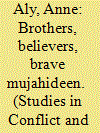

|
|
|
|
|
| Summary/Abstract |
The exponential growth in the use of the Internet and social media by terrorist actors and violent extremists has generated research interest into terrorism and the Internet. Much of this research is focused on the kinds of messages being spread via the various media platforms that host violent extremist content. This research has yielded significant insights into how organizations such as Al Qaeda and Islamic State craft their messages, the mediums they use to disseminate their messages, and the ways in which they reach their audiences. Yet we are still no closer to understanding why certain messaging appeals to certain people in certain ways and not to others. Within the literature on terrorism and the Internet, the audience—those individuals who receive messages, make meaning from them and then decide whether to act on them—is conspicuously missing. As a result, research into terrorism and the Internet can only hypothesize about the nature and extent of influence that terrorist messages wield. It is often based on an assumption that the violent extremist narrative works like a magic bullet to radicalize audiences already vulnerable and predisposed to becoming violent. Utilizing media theory approaches to studying the audience as an active agent in meaning-making, this article proposes a research framework for developing the current focus on terrorism and the Internet.
|
|
|
|
|
|
|
|
|
|
|
|
|
|
|
|
| 2 |
ID:
156147
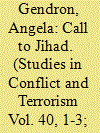

|
|
|
|
|
| Summary/Abstract |
A range of psychological, social, and environmental factors render some individuals more susceptible to militant Islam than others. Research also suggests that there are certain “triggers,” which help to explain why it is that only some individuals exposed to the same societal structural influences turn to violence. This article seeks to contribute to future empirical research in this area by studying the significance of certain “charismatic” preachers in this process and examining the role the Internet plays in strengthening the charismatic bond. Difficulties in defining and measuring “charisma” may help in part to explain the paucity of research on this aspect of radicalization but since charismatic authority derives from the bond between preacher and follower, an examination of the activities, strategies, and techniques used to build relationships and win adherents to Salafi-jihadism may provide valuable insights for countering radicalization.
|
|
|
|
|
|
|
|
|
|
|
|
|
|
|
|
| 3 |
ID:
156149


|
|
|
|
|
| Summary/Abstract |
Some scholars and others are skeptical of a significant role for the Internet in processes of violent radicalization. There is increasing concern on the part of other scholars, and increasingly also policymakers and publics, that easy availability of violent extremist content online may have violent radicalizing effects. This article identifies a number of core questions regarding the interaction of violent extremism and terrorism and the Internet, particularly social media, that have yet to be adequately addressed and supplies a series of six follow-up suggestions, flowing from these questions, for progressing research in this area. These suggestions relate to (1) widening the range of types of violent online extremism being studied beyond violent jihadis; (2) engaging in more comparative research, not just across ideologies, but also groups, countries, languages, and social media platforms; (3) deepening our analyses to include interviewing and virtual ethnographic approaches; (4) up-scaling or improving our capacity to undertake “big data” collection and analysis; (5) outreaching beyond terrorism studies to become acquainted with, for example, the Internet Studies literature and engaging in interdisciplinary research with, for example, computer scientists; and (6) paying more attention to gender as a factor in violent online extremism.
|
|
|
|
|
|
|
|
|
|
|
|
|
|
|
|
| 4 |
ID:
156145
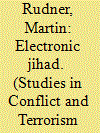

|
|
|
|
|
| Summary/Abstract |
The Internet has emerged as a key technology for Al Qaeda and other jihadist movements waging their so-called electronic jihad across the Middle East and globally, with digital multiplier effects. This study will examine the evolving doctrine of “electronic jihad” and its impact on the radicalization of Muslims in Western diaspora communities The study describes Internet-based websites that served as online libraries and repositories for jihadist literature, as platforms for extremist preachers and as forums for radical discourse. Furthermore, the study will then detail how Internet connectivity has come to play a more direct operational role for jihadi terrorist-related purposes, most notably for inciting prospective cadres to action; for recruiting jihadist operatives and fighters; for providing virtual training in tactical methods and manufacture of explosives; for terrorism financing; and for actual planning and preparations for specific terror attacks. Whereas contemporary jihadist militants may be shifting from the World Wide Web to social media, such as Facebook, YouTube, and Twitter for messaging and communications, nevertheless the Internet-based electronic jihad remains a significant catalyst for promoting jihadist activism and for facilitating terrorist operations.
|
|
|
|
|
|
|
|
|
|
|
|
|
|
|
|
| 5 |
ID:
156151
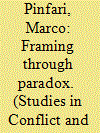

|
|
|
|
|
| Summary/Abstract |
This article presents and analyzes the “Obama supports terrorism” campaign, which was launched in Egypt in late June 2013 and was instrumental to the framing of some Islamist groups as terrorist both before and after the 3 July 2013 coup. The analysis of the visual material of the campaign highlights its reliance on various Western discourses from the War on Terror, including some whose religious and racial content is an odd fit for a non-Western, Muslim country like Egypt. Yet, despite the lack of a clear and unified causal narrative to justify such framing, the success of the campaign was crucially aided by the symbolic and rhetorical power its slogan, which provided a credible “schema of interpretation” for its supporters.
|
|
|
|
|
|
|
|
|
|
|
|
|
|
|
|
| 6 |
ID:
156157


|
|
|
|
|
| Summary/Abstract |
The introduction of the Global Terrorism Database (GTD) nearly a decade ago sparked a revolution in terrorism studies. However, one major flaw in the database continues to plague GTD users. Data lost prior to digitalization, along with unsuccessful data recollection efforts, have left GTD without data on events that took place during the year 1993. The missing data prevents researchers from using the entirety of GTD's annual range (1970–2014) to conduct reliable time-series analyses. Additionally, it has likely contributed to the formation of theories and claims on faulty empirical ground. To remedy the problem, we have collected data on 4,206 unique terror-attack incidents, with the aim of documenting the universe of 1993 terrorism events. This article showcases our 1993 dataset and illustrates the importance of terrorism events in 1993 for the development of conflicts in Israel, Afghanistan, Colombia, and India.
|
|
|
|
|
|
|
|
|
|
|
|
|
|
|
|
| 7 |
ID:
156156


|
|
|
|
|
| Summary/Abstract |
One of the most important roles in counterinsurgency (COIN) is to maintain adequate security presence to protect lives and properties of the affected population and restore law and order in the society. Accordingly, the state of affairs in Nigeria's COIN theater has been affected by the quantity and quality of security presence, most especially the ability of the operatives to gather timely and relevant information and mobilize for prompt response. Although the roles of the ground operatives have dominated public attention, the local air force and the complementary air powers have affected the security situations with the level of their presence or absence in the sky for intelligence, surveillance, and reconnaissance; firepower; and transportation in the theater. This study examines the relevance of security presence to achieve the objective of COIN and the prospects of air power in this arrangement in Nigeria and the Lake Chad region.
|
|
|
|
|
|
|
|
|
|
|
|
|
|
|
|
| 8 |
ID:
156158


|
|
|
|
|
| Summary/Abstract |
The recent influx of foreign fighters into Syria, particularly those aligning with the Islamic State, has brought renewed attention to the security threat posed by people who cross borders to participate in armed conflict. Although foreign fighters have rarely, if ever, constituted the majority of combatants in a war or insurgency, understanding their role is critical for conflict analysis and prevention. This review focuses on behavioral aspects of the foreign fighter phenomenon. Although other books and articles have focused wholly, or in part, on historical dimensions, the behavioral and social science literature on foreign fighters is much more limited. This review first explores the definitions of “foreign fighter” terminology, then analyzes what is known about their motivations and their pathways toward engaging in armed conflict on foreign soil. It examines recruitment strategies and the role of “radicalization” in feeding the transnational insurgent supply, and finally describes more specifically, the nature of foreign fighter involvement in more recent armed conflicts (e.g., Syria, Chechnya, Iraq, and Afghanistan), and speculates about the prospects for their future involvement.
|
|
|
|
|
|
|
|
|
|
|
|
|
|
|
|
| 9 |
ID:
156152


|
|
|
|
|
| Summary/Abstract |
Criminal groups around the world frequently rely on kidnapping for ransom (K&R) to fund and further their cause. Some case studies suggest war torn, fragile, and corrupt countries experience K&R epidemics more often. While such factors may be present in some countries experiencing K&R epidemics, it remains to be seen if these failed state factors are generalizable to all nations. To date, no research has systematically examined the conditions that might facilitate K&R epidemics. This study used a case-control design comparing countries with high rates of K&R (experimental) to countries without a K&R problem (control). Findings suggest that problem K&R countries were less secure, less peaceful, and unevenly developed in relation to social and economic indicators. Better understanding of the conditions involving K&R problems offers to improve foresight and the development of effective policy responses.
|
|
|
|
|
|
|
|
|
|
|
|
|
|
|
|
| 10 |
ID:
156155


|
|
|
|
|
| Summary/Abstract |
Little of the discussion of foreign fighters in Syria and Iraq is informed by primary data derived from talking with the foreign fighters. This article reports some initial findings from interviews with twenty foreign fighters in Syria. The findings are compared with three other recent studies of European foreign fighters, and aspiring fighters, based on some primary data. While those studies emphasize the role of low social and economic prospects in motivating the choice to go, this study found little evidence of such factors, and alternatively argues more attention should be given to existential concerns and the role of religiosity. Consideration is also given to the methodological challenges posed by using of terrorists' accounts of their motivations.
|
|
|
|
|
|
|
|
|
|
|
|
|
|
|
|
| 11 |
ID:
156153
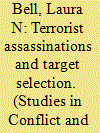

|
|
|
|
|
| Summary/Abstract |
This research note examines political institutional changes in the aftermath of terrorist assassinations. Contemporary assassinations are more often a component of wider campaigns of political violence rather than a singular attack on a head of state. The Global Terrorism Database counts 16,831 terrorist assassinations from 1970–2014, indicating significant frequency of these events and includes a wide range of targets from law enforcement officials to foreign diplomats. Utilizing survival analysis, the span of time from a terrorist assassination event to a change in political institutions within states is measured between target types. Outcome differences between target types are identified.
|
|
|
|
|
|
|
|
|
|
|
|
|
|
|
|
| 12 |
ID:
156144


|
|
|
|
|
| Summary/Abstract |
The Internet is a transformative technology that terrorists are exploiting for the spread of propaganda and radicalizing new recruits. While Al Qaeda has a longer history, Islamic State is conducting a modern and sophisticated media campaign centered around online social networking. This article introduces and contextualizes the contributions to this Special Issue by examining some of the ways in which terrorists make use of the Internet as part of their broader media strategies.
|
|
|
|
|
|
|
|
|
|
|
|
|
|
|
|
| 13 |
ID:
156150


|
|
|
|
|
| Summary/Abstract |
The kidnapping of 276 girls at Government Secondary School Chibok, Borno State, Nigeria, on 14 April 2014 has brought into international prominence the organization Jama'atu Ahlis Suna Lidda'awati Wal Jihad or Boko Haram. This incident heralded a new trajectory in Boko Haram's tactics and strategies. This article focuses on Boko Haram's strategic deployment of sexual and gender-based violence (SGBV) against women. The gendered performativity of Boko Haram, its methodology for sourcing for women and young girls, and its concomitant utilitarian/instrumental approach vis-à-vis SGBV against women are analyzed against the backdrop of the political economy and patriarchal ideational infrastructure of the Nigerian society. The article argues that Boko Haram's deployment of SGBV against women is an extension of the “repertoire of violence” ingrained in the sociopolitical and cultural milieu of Boko Haram's primary area of operation. Boko Haram's instrumental approach to SGBV is fourfold and hinges on the sociobiological utility of women. Boko Haram construes women as the bearers of its future despite its brutality toward them. The consequence is a strategic plan for procreation of a new generation of children raised through the cyclical constellation of mass rape of women, consequent impregnation and kidnapping the offspring of such rapes. Overall, this article contributes to the burgeoning scholarly literature on Boko Haram's terrorist activities.
|
|
|
|
|
|
|
|
|
|
|
|
|
|
|
|
| 14 |
ID:
156146
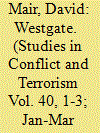

|
|
|
|
|
| Summary/Abstract |
During the Westgate terrorist attack of 2013, al-Shabaab used Twitter to claim responsibility for and live tweet throughout the attack. This article analyzes 556 of these tweets to understand the motivations for using Twitter during ongoing terrorist operations and builds up a picture of how al-Shabaab interacted with Twitter throughout the Westgate attack. Conclusions arising from the analysis include that al-Shabaab were primarily concerned with controlling the narrative of the attack and retaining an audience. In addition, the tweets were aimed at a specific geographical audience, indicating that the Westgate attack was primarily motivated by territorial concerns.
|
|
|
|
|
|
|
|
|
|
|
|
|
|
|
|
| 15 |
ID:
156154
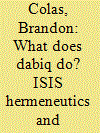

|
|
|
|
|
| Summary/Abstract |
The Islamic State of Iraq and Syria (ISIS)'s flagship English-language magazine, Dabiq, is a puzzle. The magazine is not, despite appearances, primarily designed for direct recruiting efforts or inciting violence against the West. In fact, the primary audiences of Dabiq are English-speaking second generation Muslims or converts, Western policymakers, and a third group of current or would-be members of ISIS who are not integrating with the organization itself. The third audience—those members who are failing to function within the organization—is strange to include in an English-language magazine. Why publish organizational weaknesses, in English? One possibility for this puzzle is that the fundamentalist hermeneutics of ISIS is reflected in their own media efforts. One of the assumptions that ISIS holds about their sacred texts is that each text carries a single meaning that reflects the author's original intent. There might be multiple applications of that intent, but each text can only have one intent, and therefore one meaning. Following this logic, a message meant for one person is unlikely to be of utility for another, and so this may be why ISIS exposes their weaknesses as part of the process of correcting their own members.
|
|
|
|
|
|
|
|
|
|
|
|
|
|
|
|
|
|
|
|
|